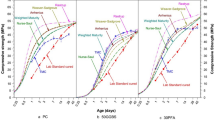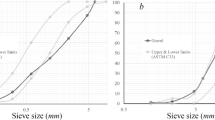Abstract
The concepts of maturity and activation energy have been primarily used for prediction of compressive strength. Less frequently, these principles have been used for investigation of the temperature–time relationship of other properties. In this research, electrical conductivity was monitored over time for the period of 1–28 days for 10 concrete mixtures. It was found that the typical relationship that holds for compressive strength in relation to the maturity does not hold for conductivity. In addition, activation energy was determined by the Arrhenius relationship using four methods of calculating the rate constant. Values calculated for activation energy varied considerably depending on the method used with the exponential rate constant giving the lowest values. Comparing results to published literature, the linear hyperbolic method most often cited gives similar values of activation energy in this research to those published for either hydration or strength.








Similar content being viewed by others
References
Abdel-Jawad YA (2006) The maturity method: modifications to improve estimation of concrete strength at later ages. Constr Build Mater 20:893–900
ASTM (2011) C1074 Standard practice for estimating concrete strength by the maturity method. ASTM International, West Conshohocken. doi:10.1520/C1074-11
ASTM (2012a) ASTM C150 (Standard specification for portland cement). ASTM International, West Conoshohoken
ASTM (2012b) ASTM C1202 (Standard test method for electrical indication of concrete’s ability to resist chloride ion penetration). ASTM International, West Conshohocken, PA
ASTM (2012) ASTM C 1760 (Standard Test Method for Bulk Electrical Conductivity of Hardened Concrete). ASTM International, West Conoshohocken
ASTM (2013) ASTM C 918 (Standard Test Method for Measuring Early-Age Compressive Strength and Projecting Later-Age Strength). ASTM International, West Conshohocken
Barnett S, Soutsos M, Millard S, Bungey J (2006) Strength development of mortars containing ground granulated blast-furnace slag: effect of curing temperature and determination of apparent activation energies. Cem Concr Res 36:434–440
Bernhardt C (1956) Hardening of concrete at different temperatures. In: Proceedings of RILEM Symposium
Brooks AG, Schindler AK, Barnes RW (2007) Maturity method evaluated for various cementitious materials. J Mater Civ Eng 19:1017–1025
Carino NJ (1984) The maturity method: theory and application. Cem Concr Aggreg 6:61–73
Carino NJ, Lew H (2001) The maturity method: from theory to application. In: Chang PC (ed) Structures congress and exposition. ASCE, Washington, DC, p 19
Carino NJ, Tank RC (1992) Maturity function for concretes made with various cements and admixtures. ACI Mater J 89:188–196
Chrisp TM, Starrs G, McCarter WJ, Rouchotas E, Blewett J (2001) Temperature-conductivity relationships for concrete: an activation energy approach. J Mater Sci Lett 20:1085–1087. doi:10.1023/A:1010926426753
Ezziane K, Kadri E, Hallal A, Duval R (2010) Effect of mineral additives on the setting of blended cement by the maturity method. Mater Struct 43:393–401
Freiesleben Hansen P, Pedersen EJ (1977) Maturity computer for controlled curing and hardening of concrete. Nordisk Berong 1:19–34
Garcia A, Castro-Fresno D, Polanco JA (2008) Maturity approach applied to concrete by means of vicat tests. ACI Mater J 105:445–450
Geiker M (1983) Studies of Portland cement hydration by measurements of chemical shrinkage and a systematic evaluation of hydration curves by means of the dispersion model. PhD, PhD, Technical University of Denmark
Han M-C, Han C-G (2010) Use of maturity methods to estimate the setting time of concrete containing super retarding agents. Cem Concr Compos 32:164–172. doi:10.1016/j.cemconcomp.2009.11.008
Han S-H, Kim J-K, Park Y-D (2003) Prediction of compressive strength of fly ash concrete by new apparent activation energy function. Cem Concr Res 33:965–971. doi:10.1016/S0008-8846(03)00007-3
Hansen PF, Pedersen E, Konstruktionsinstituttet B (1984) Curing of concrete structures. BKI
Helland S (1987) Temperatur og Fasthetsutvikling i Betong med v/c Iavere enn 0.40 (in Norwegian). J Nord Concr Fed 5:26–29
Jonasson J (1985) Early strength growth in concrete—preliminary test results concerning hardening at elevated temperatures. In: Proceedings of 3rd International RILEM symposium on winter concreting, pp 249–254
Julio-Betancourt G, Hooton R (2004) Study of the Joule effect on rapid chloride permeability values and evaluation of related electrical properties of concretes. Cem Concr Res 34:1007–1015
Kada-Benameur H, Wirquin E, Duthoit B (2000) Determination of apparent activation energy of concrete by isothermal calorimetry. Cem Concr Res 30:301–305
Kjellsen K, Detwiler R (1993) Later-age strength prediction by a modified maturity model. ACI Mater J 90:220–227
Knudsen T (1980) On particle size distribution in cement hydration. In: Proceedings, pp 1–170
Knudsen T (1984) The dispersion model for hydration of Portland cement I: General Concepts. Cem Concr Res 14:622–630
Lachemi M, Hossain K, Anagnostopoulos C, Sabouni A (2007) Application of maturity method to slipforming operations: performance validation. Cem Concr Compos 29:290–299
Lei WG, Struble LJ (1997) Microstructure and flow behavior of fresh cement paste. J Am Ceram Soc 80:2021–2028
Lew H, Reichard T (1978) Prediction of strength of concrete from maturity. In: Malhotra VM (ed) Accelerated strength testing. American Concrete Institute, Detroit, pp 229–248
Liao WC, Lee B, Kang C (2008) A humidity-adjusted maturity function for the early age strength prediction of concrete. Cem Concr Compos 30:515–523
Ma W, Sample D, Martin R, Brown P (1994) Calorimetric study of cement blends containing fly ash, silica fume, and slag at elevated temperatures. Cem Concr Aggreg 16:93–99
McCarter W, Starrs G, Chrisp T (2000) Electrical conductivity, diffusion, and permeability of Portland cement-based mortars. Cem Concr Res 30:1395–1400
McGrath PF (1997) Development of test methods for predicting chloride penetration into high performance concrete. University of Toronto
Myers JJ (2000) The use of maturity method as a quality control tool for HPC bridge decks. In: PCI/FHWA/FIB International Symposium on High Performance Concrete
Naik TR (1992) Maturity of concrete: its applications and limitations, Department of Civil Engineering and Mechanics, College of Engineering report
Neville AM (1996) Properties of concrete, 4th edn. John Wiley & Sons, New York
Parrott LJ, Geiker M, Gutteridge WA, Killoh D (1990) Monitoring Portland cement hydration: comparison of methods. Cem Concr Res 20:919–926
Pinto R, Hover K (2000) Combined effects of silica fume, superplasticizer and temperature on setting behaviour. Mag Concr Res 52:345–352
Pinto R, Schindler A (2010) Unified modeling of setting and strength development. Cem Concr Res 40:58–65
Pinto RC (1997) The effect of curing temperatures on the development of mechanical properties of fresh and hardened high-strength silica fume mixtures: a maturity approach. Cornell University
Plowman JM (1956) Maturity and the strength of concrete. Mag Concr Res 8:13–22
Poole JL, Riding KA, Folliard KJ, Juenger MCG, Schindler AK (2007) Methods for calculating activation energy for Portland cement. ACI Mater J 104:86–94
Poole JL, Riding KA, Juenger MCG, Folliard KJ, Schindler AK (2010) Effects of supplementary cementitious materials on apparent activation energy. J ASTM Int 7:1–6. doi:10.1520/JAI102893
Presuel-Moreno F, Liu Y (2012) Temperature effect on electrical resistivity measurements on mature saturated concrete In: Corrosion 2012, Salt Lake City, UT. NACE, pp 5678–5696
Radlinski M, Olek J, Nantung T (2010) Development and application of maturity method for prediction of concrete’s resistance to chloride ion penetration. Transp Res Rec 2164:105–112
Sant G, Rajabipour F, Weiss J (2008) The influence of temperature on electrical conductivity measurements and maturity predictions in cementitious materials during hydration. Indian Concr J 82:7–16
Schindler AK (2002) Concrete hydration, temperature development, and setting at early-ages. PhD, The University of Texas at Austin
Schindler AK, Folliard KJ (2005) Heat of hydration models for cementitious materials. ACI Mater J 102:24–33
Spragg R, Villani C, Snyder K, Bentz D, Bullard JW, Weiss J (2013) Factors that influence electrical resistivity measurements in cementitious systems. Transp Res Rec 2342:90–98
Tepke D, Tikalsky PJ (2001) Concrete maturity progress: survey of departments of transportation. Transp Res Rec 1775:125–131
Tepke DG, Tikalsky PJ, Scheetz BE (2004) Concrete maturity field studies for highway applications. Transp Res Rec 1893:26–36
Turcry P, Loukili A, Barcelo L, Casabonne JM (2002) Can the maturity concept be used to separate the autogenous shrinkage and thermal deformation of a cement paste at early age? Cem Concr Res 32:1443–1450
Villagrán Zaccardi Y, Fullea García J, Huelamo P, Di Maio A (2009) Influence of temperature and humidity on Portland cement mortar resistivity monitored with inner sensors. Mater Corros 60:294–299
Voigt T, Sun Z, Shah SP (2006) Comparison of ultrasonic wave reflection method and maturity method in evaluating early-age compressive strength of mortar. Cem Concr Compos 28:307–316
Volz CK, Tucker RL, Burns NH, Lew H (1981) Maturity effects on concrete strength. Cem Concr Res 11:41–50
Wade SA, Nixon JM, Schindler AK, Barnes RW (2010) Effect of temperature on the setting behavior of concrete. J Mater Civ Eng 22:214–222
Wei X, Xiao L (2010) Determination of activation energy of cement hydration by electrical resistivity measurement. Paper presented at the 2nd International Symposium on Service Life Design for Infrastructure, Delft, The Netherlands
Weiss J, Snyder K, Bullard J, Bentz D (2012) Using a saturation function to interpret the electrical properties of partially saturated concrete. J Mater Civ Eng 25:1097–1106
Wirquin E, Broda M, Duthoit B (2002) Determination of the apparent activation energy of one concrete by calorimetric and mechanical means—influence of a superplasticizer. Cem Concr Res 32:1207–1213. doi:10.1016/S0008-8846(02)00770-6
Acknowledgments
The author is grateful for funding obtained through the Natural Sciences and Engineering Research Council of Canada (NSERC). The assistance of undergraduate student Mr. Stephen Chun for the experimental work and to Dr. Attila Zsaki for the development of the automated measurements are appreciated.
Author information
Authors and Affiliations
Corresponding author
Rights and permissions
About this article
Cite this article
Nokken, M.R. Electrical conductivity to determine maturity and activation energy in concretes. Mater Struct 49, 2209–2221 (2016). https://doi.org/10.1617/s11527-015-0644-0
Received:
Accepted:
Published:
Issue Date:
DOI: https://doi.org/10.1617/s11527-015-0644-0




